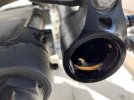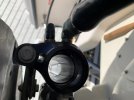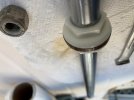I have a 22' GW with 250 Yamaha 4 stroke. The boat veers to port side, I continually need to steer to starboard to compensate. I have disassembled the helm and everything seems to be moving freely and re-bled the system, doing same thing. Also, I find that when I tilt the motor up and leave it in center position, when I return the next day, the motor has flopped to one side or the other.
5 star marine down in Florida that rebuilds these systems, thought it might be a cracked inner plastic bushing and o-ring, thus leaking from side to side. But Seastar will not sell them that part so can't be rebuilt. They suggested to buy a new one. I also tried adjusting the trim zinc, did not seem to do much?
In the meantime, I dis-assembled the Seastar Cylinder. I expected to find an o-ring or gasket mounted on a plastic piece centrally located on the shaft. It is not an o-ring instead it looks like a brass like disc sandwiched between 2 plastic pieces. I suspect that it works by having a close tolerance fit between the disc and the bore of the cylinder. Could this be worn to the point that fluid is leaking from one side to the other? I'm not convinced of that, It looks to be in good shape. I don't want to spend $600 on a new cylinder to find out that it is not the problem.
Has anyone else had this issue? any other ideas?
Paul
5 star marine down in Florida that rebuilds these systems, thought it might be a cracked inner plastic bushing and o-ring, thus leaking from side to side. But Seastar will not sell them that part so can't be rebuilt. They suggested to buy a new one. I also tried adjusting the trim zinc, did not seem to do much?
In the meantime, I dis-assembled the Seastar Cylinder. I expected to find an o-ring or gasket mounted on a plastic piece centrally located on the shaft. It is not an o-ring instead it looks like a brass like disc sandwiched between 2 plastic pieces. I suspect that it works by having a close tolerance fit between the disc and the bore of the cylinder. Could this be worn to the point that fluid is leaking from one side to the other? I'm not convinced of that, It looks to be in good shape. I don't want to spend $600 on a new cylinder to find out that it is not the problem.
Has anyone else had this issue? any other ideas?
Paul





